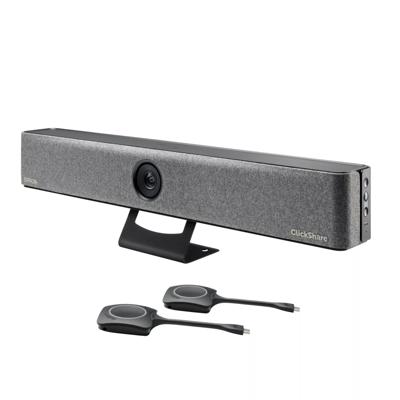
ClickShare Bar Pro
Premium video bar for engaging, effortless wireless conferencing in medium-sized meeting rooms.
A changing climate caused by unabated carbon emissions is a key challenge of our times, and the consequences looming on the horizon are devastating. Change is in order.
Governments and global organizations alike are taking transformative measures to combat climate change. Barco and ClickShare are no different.
We are enacting real climate action by significantly reducing our carbon footprint and that of our customers, and have taken strides on our way to a better future.
ClickShare is spearheading these efforts by developing performant, carbon-neutral wireless collaboration devices that offer premium hybrid meeting experiences.
Check the facts and discover how ClickShare is working towards a greener future, one meeting room at a time; and why not work together?

When working to reduce ClickShare´s carbon footprint, we focused on seven areas that have the highest impact: design, materials, production, packaging, transportation, usage and recycling.
Right from the onset, every ClickShare product is designed with environmental responsibility in mind.
Our design process prioritizes not only the functionality and aesthetics of our products but also the environmental impact at every stage of the lifecycle.

We are meticulous about the materials we use in our products and utilize recycled materials in both our product manufacturing and our informational materials:
The ClickShare CX-50 2nd gen incorporates 33% PCR plastic, while the ClickShare Video Bars, along with the ClickShare Conference CX-20 and CX-30, ClickShare Present C-5 and C-10, and the ClickShare Button, include 35% PCR plastic.

We work closely together with manufacturers that undersigned the supplier code of conduct. Each year:

We strive to make our packaging as light as possible and use recycled or recyclable materials: cardboard for the product boxes and sugarcane for the product trays. Sugarcane is a fully recyclable material, can be reused several times and it biodegrades in a matter of months.

We aim to ship our products as much as possible by sea, followed by trucks and then by plane, which accounts for significantly fewer carbon emissions.

Our products are optimized to be as energy efficient as possible.
All ClickShare devices not only comply to the strictest EPR legislation (The EU Ecodesign for Sustainable Products Regulation) requirements for standby mode but further reduce it to half the mandated limit (*Based on power consumption test report from our lab).
For instance, the ClickShare Video Bar range is 30% more energy efficient than competitive products in BYOD mode (according to in-house measurements and comparisons).

We take into consideration the end of life of our product from the very beginning, making sure all parts can be easily disassembled, making recycling also easier.
We offer the ClickShare Trade-in Program so you can return your old ClickShare solution in exchange for a significant discount for a new, more sustainable device. No need to worry about recycling, we´ll take care of that!

2016: Introducing Standby powermode for more energy efficiency (<0.5W)
2017: Launch of CSE-800 at improved volume metric packaging concept
2018: Implementation of Barco Eco Label scoring (ClickShare currently complies to every latest update of this eco scoring)
2019: First ClickShare product with Eco Score (Button Gen4 A+)
2020: Launch of SmartCare + extended warranty to ensure a longer product lifecycle
2021
2022
2023
2024
The carbon-neutral label certifies that a company's carbon footprint is calculated, reduced, and offset on a yearly basis. It is issued by the climate advisory organization CO2logic—a South Pole company, and validated by the accredited and independent certification body Vinçotte.

Premium video bar for engaging, effortless wireless conferencing in medium-sized meeting rooms.

Video bar for engaging, effortless wireless conferencing in small and medium-sized meeting rooms.

Premium wireless video conferencing solution for high-impact meeting rooms

To measure our products´ environmental footprint, we have developed the Barco Ecoscoring score focusing on Energy, Materials, Packaging & Logistics, and End-of-life. The framework is defined in the ISO 14021 standard and the methodology was validated by the Vinçotte experts.

Easy wireless conferencing for small meeting rooms and huddle spaces

Seamless wireless conferencing for medium-sized conference rooms

High-end wireless conferencing for large meeting spaces

Simple, one-click wireless presentation for huddle spaces.

Interactive wireless presentation for any meeting space
Don't hesitate to contact us with your questions. Our team will gladly point you in the right direction.